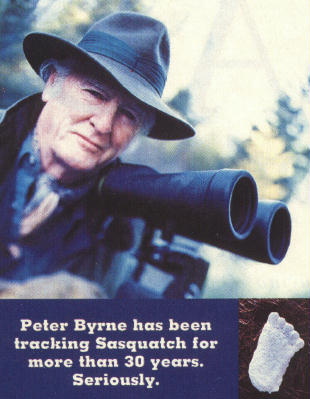WESTERN WANDERINGS
With Peter Byrne
by Peter Fish
Peter Byrne sketches a squiggly map. "Northern California" he
says. "The Cascades of Oregon and Washington. There are enormous
areas of British Columbia with no people. Perfect for Bigfoot."
Bigfoot! The name sparks terror and awe...well, actually it doesn't
spark either, does it? It sparks giggles, and that what kind-of-an-idiot-do-they-take-me-for
impatience you feel watching a TV show like "Ancient Mysteries."
 But
up near Oregon's Mount Hood, Peter Byrne commands The Bigfoot Research
Project, hoping to prove once and for all that the huge beast of the Pacific
Northwest does, in fact, exist.
But
up near Oregon's Mount Hood, Peter Byrne commands The Bigfoot Research
Project, hoping to prove once and for all that the huge beast of the Pacific
Northwest does, in fact, exist.
Peter Byrne is not
a kook. It is a measure of Bigfoot's dubious reputation that Byrne's stability
is the first thing that must be mentioned here. Nearing 70, Byrne has
the aristocratic bearing you would expect of an ex-RAF officer, which
he is. At the end of World War II, Byrne lingered in India to manage a
tea plantation, then moved on to lead safaris in Nepal. He is the only
person I have ever met who can toss off with utter aplomb a sentence like "We were tracking the big cats."
This is not Byrne's first attempt at snaring Bigfoot. In 1960, a Texas
oil millionaire hired him to scour Northern California's Trinity Alps
fm the creature, and in the 1970s Byrne expanded his search to the Cascades---experiences
that inspired his book The Search for Bigfoot. Now Byrne and The Bigfoot
Research Project--a five-year endeavor funded by a consortium of businessmen--are
forgoing on-the-ground tracking in favor of electronic surveillance.
Descriptions of Bigfoot, or Sasquatch, as the Salish called him, display remarkable consistency. The creatures----enthusiasts believe there may be as many as 300--have, yes, big feet. "Prints indicate 14 to 15 inches," Byrne says. They are tall: "Seven feet tall is the usual description." They are hirsute: "Always dark black hair, or dark brown." They smell: "The odor is sweetish sour, not exactly rotting meat but close to it, not skunk but close to it." And they are shyly benign: "The descriptions are almost monotonous," Byrne says. "Once spotted, the creatures turn and walk away. A loping, gliding walk."
Byrne and his associates are trying to gather as many potentially credible sightings as possible. After three years, the tally is 250, many of which have come through the project's toll free number, (800) BIGFOOT. The day I visit project headquarters, the phone rings constantly if not always constructively. "Kids," Byrne says, "love calling us as a joke." But he has received more promising calls as well. "We just had a very interesting sighting. On the Washington coast. A couple. Professional. They called a friend, who called us--it often happens that way. There's a fear of ridicule."
Once a sighting is deemed credible, Byrne asks witnesses to fill out the project's surveys--Footprint Finding Questionnaire; Sounds, Smells, and Object throwing Questionnaire--whose queries run along these lines: Did the face have any human characteristics and, if so, can you compare it with the face of anything you have ever seen, in particular, the speculative representations that have been done of the face of Gigantopithecus, the giant Chinese primate of prehistoric times?
Gigantopithecus, Byrne believes, is one possible Bigfoot link. "It lived in those parts of Asia from where primitive people first came to North America." Did it come across with them? "After almost 30 years of searching, we know almost nothing. We speculate that it's hominid. We speculate that it's nocturnal. To be blunt, that's where we are. I meet people who say, 'You're the expert.' But I'm not. I've just been looking for a long time."
Byrne did hear Bigfoot once. He was camping on the Oregon coast near Cannon Beach. "I heard something that was not any animal I knew here. A screaming roar, twice, with an interval of 5 seconds, each call lasting 5 seconds. It shocked me out of my sleeping bag. The volume. The power."
Soon, Byrne expects, the project will have enough sightings to determine places and times for likely Bigfoot appearances. Bryne and his associates will then set up sensors and night-vision cameras in select locales. They will have four wheel-drives, helicopters, and teams of trackers ready, waiting.
Other Bigfoot hunters have urged that the creature be killed for examination. Byrne would take a tissue sample but opposes violent measures. "Mind you, if we were dealing with a dangerous creature, it would be different. But there is no record that Bigfoot has ever shown the slightest sign of aggression."
Instead, Byrne hopes, one day the sensors will beep and helicopters and trackers will swing into action. Byrne will be with them. He will spot something tall and hairy, with a loping gait. He will get a photograph, a tissue sample, a good long look. And then Peter Byrne will let Bigfoot glide back into the forest and slip away.
Seen something big skulking in the woods?
Write or call The Bigfoot Research Project
Box 126, Mount Hood, OR 97041
(800) 244-3668 or (503) 352-7000
(These are no longer working numbers, 2001, Mr. Byrne is retired.)
© SUNSET MAGAZINE 1996 from the files of Bobbie Short
Back to What's New?
Back to Newspaper & Magazine Articles
Home/Main
http://www4.law.cornell.edu/uscode/17/107.html
This proviso is applicable throughout the entire website.